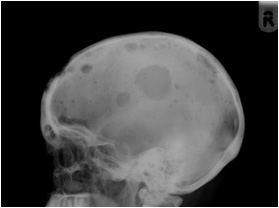Bone Survey
Table of Contents
A bone survey, also called a skeletal survey, is a series of X-rays that look at the bones in your body. Bone surveys are used to look for bones affected by cancer.
Bone surveys are often used to diagnose multiple myeloma or to see how far the cancer has spread. Multiple myeloma causes bones to break down. There can be lesions that look like holes in the bones (lytic lesions) on X-rays. Bone surveys can also show:
- Loss or thinning of the bone (osteoporosis or osteopenia).
- Bone fractures (breaks).
- Past bone injuries.
How do I prepare for a bone survey?
Wear comfortable clothes and shoes that are easy to change in and out of. The appointment takes at least an hour. The amount of radiation you get is small. If you are pregnant, let your provider know.
What can I expect during the test?
During the test, the radiology technician will take a series of X-rays. The exam will take 20-40 minutes, depending on how many X-rays are needed. You will either be lying down or standing up for the X-rays. The technician will put you in different positions to get the best images of all your bones.
The technician will come and go from the room when taking the X-rays to avoid radiation exposure. When they leave the room, they will be nearby in an area where they can see and hear you.
How do I get the results of my bone survey?
A radiologist reviews the x-rays and writes a report for your provider. The report will go over normal and abnormal findings. Your provider will talk to you about your results.
If your bone scan was done to look at multiple myeloma or another type of cancer, your provider will be looking for differences in the bone that are not normal, such as lytic lesions, lucent (clear or see-through) lesions, or punched-out lesions.
If you have any questions about your bone survey or the results, talk with your provider.
